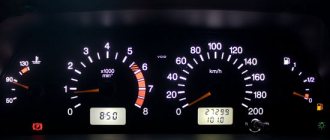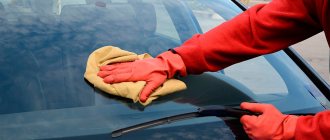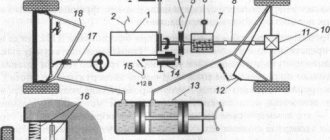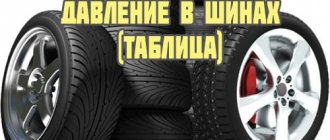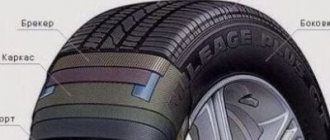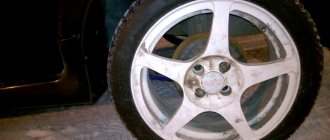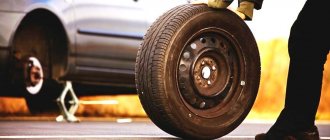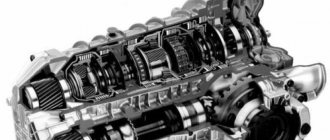How many atmospheres should be in a car’s tires is a question that begins to worry any car owner immediately after purchasing a car. Incorrect tire pressure can not only lead to rapid wear of expensive tires and other vehicle components. But also affect driving safety, especially in critical situations on the road.
If your tires are not properly inflated, your ride will not be as smooth and comfortable as your vehicle was designed to be.
How much should tire pressure be?
Tire pressure is an important indicator that every driver should carefully monitor. Typically, tire pressure is determined by each manufacturer separately for a specific model. This value is indicated by the manufacturer on the driver's or passenger's door.
Data locations by car model difference
And also on the body pillar or the inside of the gas tank cap. Please refer to your vehicle manual for the exact information for your model.
Often this value will be the same for the front and rear wheels, but on some models it varies. A decrease or increase in pressure of just 20% can significantly affect vehicle wear and driving safety. The car manufacturer indicates the frequency of checking tire pressure in the instructions.
Where to find the correct tire pressure for your car
The tire pressure is determined by the car manufacturer; through tests, he finds out to what limits the tires can be inflated. The data must be indicated in the documents accompanying the vehicle.
For greater simplicity, additionally indicate the parameters in the plate. It can be found on the A-pillar of the car or on the inside of the gas filler flap. In rare cases, a plate with basic technical parameters may be located on the door. All you have to do is find the sign on your car and see what pressure to pump the tires to.
Units for determining car tire pressure
Pressure units are typically divided into those used in the European region, such as Bar (bar) or Atmosphere (atm). PSI values are suggested for the American region.
The conversion table for these units is as follows:
| 1 | bar | = | 0.98 | atm |
| 1 | bar | = | 1.02 | kgf/cm2 |
| 1 | psi | = | 0.068 | atm |
| 1 | atm | = | 1.03 | kgs/ua |
| 1 | atm | = | 14.7 | psi |
Since the error between bar and atm is insignificant, in domestic automobile markets Bar is often equated to Atmosphere.
These indicators depend solely on the car model, and not on the brand of tires used.
The car manual always contains information about what pressure should be in the car tires, and in what units it is determined for your car.
What devices measure tire pressure?
For this measurement method there is a special device - a pressure gauge. It comes in several types:
- switch;
- digital;
- mechanical.
Pointer and mechanical are inexpensive devices to use. The digital pressure gauge has an electronic display on which the measurements are displayed.
measured by pressure gauge
In addition to standard instruments, measuring caps are available on the market. Which are screwed onto each wheel and show the pressure in the tire by changing color.
There is a more expensive version of caps that are screwed into the wheel and transmit information to the driver’s electronic display. This way you can quickly control the pressure in the wheels of your car.
How to inflate a tire with your own hands
Inflating a car tire is not difficult, but a beginner may have a few questions. Let's look at the stages of the process, and in the end you will know how to properly inflate a tire. To work, you will need a pump, you can use a foot pump, or a compressor. Now there are compressors that operate from a cigarette lighter. If the pump does not have a pressure gauge, this device will also be needed.
Let's take a step-by-step look at how a tubeless tire is inflated.
- We put the car on the handbrake. It is advisable to choose a level place.
- We take out the pump and pressure gauge. If the compressor is electric, connect it to power. Usually the connection occurs through the cigarette lighter; we simply insert the tip of the cord into the cigarette lighter.
- Unscrew the protective cap from the tire nipple. The cap must be placed carefully to the side so as not to be lost.
- Connect the hose tip to the wheel. To do this, the tip is simply put on the nipple, at the beginning you will hear the sound of air escaping. This is fine. Push the tip in completely.
- Then turn the handle of the tip at an angle of 90°. This way we will secure the hose to the nipple.
- We look at the pressure gauge. It shows the tire pressure if we turn on the compressor insufficiently. We wait until the pressure gauge shows a normal parameter.
- Disconnect the tip. This must be done carefully, but quickly enough.
- Screw on the previously removed cap.
Next, we repeat all the described procedures on the remaining wheels, including the spare one. Now the car is ready to go.
If the pump is foot-operated, all actions are similar, except for connecting to power. The air supply is carried out by driving the pump piston, this is done with the foot.
Inflating a car tire is not a difficult job. Every car owner can do this, even without any experience. The main thing is to know the basic rules, they are simple, and it won’t be difficult to follow them. But you will save time on a trip to a car service center.
How often to check tire pressure
Some experts point out that you need to check the tire pressure every day before leaving your car on a route. However, the driver does not always have time for such checks. Therefore, if you conduct such an inspection once every one or two weeks, then this will be quite enough.
It is also worth checking before a long trip. So that you feel comfortable on the road and avoid unpleasant surprises with flat tires.
After a long period of parking, you should also pay careful attention to the pressure. Which should be in the tires, since during this time the pressure could have dropped slightly.
For measurement accuracy, this check should only be carried out on cold tires, or after stopping for at least 3 hours.
When can you rock the wheels?
There are certain pumping rules. They include not only data on how much air to pump into the tire, but also when to do it. The main requirement is to inflate the tire only after a long period of parking. The tire heats up while driving. According to physical laws, temperature directly affects gas pressure. Accordingly, immediately after stopping the indicator will not be accurate.
It is necessary to wait until the air temperature in the tire becomes equal to the outside temperature. This takes 3-4 hours. After waiting this long, you can accurately measure the pressure. It is most convenient to measure pressure and pump in the morning, after parking overnight.
What is the best way to inflate a wheel?
The easiest way to do this is by specialists at a service station, who can specify the required pumping parameters.
If you are a car enthusiast who prefers to inflate the tires yourself. To do this you will need to complete the following steps:
- the car should be put on the handbrake;
- prepare a pump (manual, foot or electric) and a pressure gauge. Some automobile pumps are manufactured with a pressure gauge already built-in;
- unscrew the protective cap, connect the pump hose to the wheel and secure it;
- if a pressure gauge is not included in the design of your pump, you should check the pressure readings and, if necessary, pump up the wheels;
- After pumping is complete, you need to disconnect the pump and quickly put on the cap.
Recommended tire pressure
Often the car manufacturer gives a range of possible tire inflation values depending on whether the car is loaded or you will be driving lightly. Also, if you are planning different types of trips, you can adhere to the following recommendations:
- On a smooth asphalt road, it is best to pump up the tires to the maximum allowable level. This will make your movement more comfortable and reduce fuel consumption;
- on a dirt road, on the contrary, you need to reduce the tire inflation to the minimum permitted parameter, then the adhesion of the tires to the road surface will not be so rigid;
- When driving on city streets and mixed roads, the average tire inflation rate is set.
Why is it important to keep your tire pressure normal?
Tire pressure is an important parameter; it is responsible for the main technical characteristics of the wheel. The car manufacturer calculates this parameter in advance and indicates it in the recommendations.
If the tire is under-inflated, this will primarily lead to increased fuel consumption. This is due to a decrease in the rolling coefficient. Uneven traction with the road surface also occurs, leading to a decrease in traffic safety; this is felt in the form of more difficult driving. Tire wear increases; with a strong drop in pressure, the rim of the disc can cut the sidewall.
It's also not a good idea to overinflate your tires. The tire will wear unevenly and the middle part of the tread will suffer. Increased pressure can cause an explosion and complete destruction of the tire on the road. In addition, wheel stiffness will increase and braking efficiency will decrease.
Consideration of seasonal fluctuations
It is worth monitoring the tire inflation level more carefully during the off-season. Since an inflated wheel has the ability to change its performance depending on the air temperature. This pressure change rate is approximately 0.1 bar for every 10 degrees of temperature change. This is especially felt on large wheels with a volume of 60-65 liters.
If you have replaced summer tires with winter tires, they should be monitored with each subsequent drop in temperature, especially when frosts begin. So it’s worth checking the indicators if the air temperature drops below 10, 15 and 20 degrees. As the air temperature decreases, tire inflation rates drop, and as the ambient temperature rises, these values will increase.
Optimal car tire pressure
After studying the manual for your car model, you will know exactly what tire pressure you should stick to. Some manufacturers indicate a range taking into account natural fluctuations, as well as machine load. That is, how much you can deviate from the agreed norm.
For some models, this value differs for the front and rear wheels. For most standard passenger cars at an average load level, this figure can be 2-2.5 atmospheres.
With this indicator, you will save maximum fuel resources and feel comfortable on the road. At the same time, do not forget that the maximum pressure value is an indicator that the wheel itself can withstand without bursting.
Increased pressure in car tires
When the wheel is inflated, only the central part of the tire comes into contact with the road, due to which the following can occur:
- the center stripes of the wheel wear out, which reduces the service life of the wheels;
- stiffness increases - such a trip ceases to be comfortable;
- noise increases at fast speeds;
- the risk of tire rupture and creating an emergency on the road increases.
Low pressure in car tires
With underinflated tires, the wheels come into contact with the road with their outermost stripes. In this case, the driver may experience many unpleasant situations:
- uneven wear of the wheels occurs, which leads to the rapid need to replace tires;
- fuel consumption increases;
- the braking distance becomes longer, the possibility of the car skidding appears;
- Waves form in the side parts of the tires, which can interfere with the alignment of the car in an unusual situation on the road.
avtoexperts.ru
It would seem that what’s so difficult about pumping up the tires of your car? But, nevertheless, even such a simple operation, in general, raises many questions that we cannot ignore. But before we talk about the process of inflating wheels, let’s remember why it is necessary to maintain optimal pressure in them.
The wheels of a car are the part that connects the car to the road. And such non-trivial things as fuel consumption, suspension condition and car handling depend on how correctly the tires are inflated. It’s not in vain that car manufacturers spend a lot of time on tests, during which the optimal tire pressure parameters are measured. These tests are carried out in various climatic conditions, on tracks with different types of surfaces. Based on the results of these tests, the nominal tire pressure is determined depending on how loaded the car is. And the manufacturer strongly recommends inflating tires according to these indicators, guaranteeing, for its part, fuel consumption close to the passport data, good handling and durability of suspension components and parts. By the way, this data is not a secret; in every car there is a plate on the middle pillar on the driver’s side that shows the pressure numbers for the front and rear wheels depending on the load. And for each model these numbers are different, there are no average values. Although in some countries, including Russia, this data is often neglected, for many models the “average temperature in the hospital” still applies.
Tire pressure data from the manufacturer Hyundai
There is no difference in how to inflate the wheels of a car - with ordinary air or a gas mixture (nitrogen) - since both components practically do not differ in composition. And the difference in the composition of regular air and the gas mixture is minimal and, therefore, cannot significantly affect the characteristics of the tire. The main thing is to comply with quantitative indicators, since both the condition and durability of the tire itself, as well as the above parameters - fuel consumption and the service life of the car suspension - directly depend on whether there is excessive or insufficient pressure in the tire. It is better to start the actual procedure of inflating the wheels when the tires are “cold” - that is, when the car has not driven anywhere yet. This is explained by the fact that in a “cold” tire the air pressure is close to optimal, and when driving, especially in hot weather, the air pressure increases in proportion to the air temperature. That is, if you measure the pressure in the morning and the pressure gauge shows, say, 2.0 atm, then taking measurements after half an hour of driving, you can see that the pressure in the tire will increase by 0.3 - 0.5 atm.
Tire inflation
There is also some disagreement among car enthusiasts about whether it is worth over-inflating tires or whether it is better to keep the pressure in them at 0.2 - 0.3 atm. below the parameters recommended by the manufacturer. The fact is that a tire that is not inflated to the recommended parameters comes into contact with the road surface over a larger surface (the so-called “contact patch” grows), which leads to gradual wear of the outer edges of the tread. In addition, the vehicle's fuel consumption increases. There are, however, some positive aspects. An underinflated tire allows you to reduce the load on the suspension elements, which increases ride comfort and extends the life of chassis parts. Another point: such “soft” tires reduce the braking distance of the car, which has a positive effect on safety. But this aspect also has its own negative point - a car with “soft” tires listens worse to the steering wheel, and therefore the car’s handling suffers.
Over-inflated tires are also not good. First of all - for the same suspension. A hard tire will transfer more shock to the suspension components than an optimally or underinflated tire. Over time, suspension parts may fail, and driving on such tires is not comfortable. That is why it is better to stick to the “golden mean” when it comes to tire inflation.
Replacing a flat tire
In a situation where rolling does not help a flat tire and it continues to go flat at varying intervals. You should make a replacement using the spare tire and contact a car service for a tire fitting service. After all, the most difficult situation on the road can arise precisely when the car’s wheels have different degrees of inflation.
With such indicators, fuel consumption increases significantly. The car begins to roll towards the least inflated wheel. Which leads to its rapid and uneven wear. Other vehicle systems may also not function properly.
And your ride will become very uncomfortable and even dangerous.
The error message “Check tire pressure” appears on the panel - what should I do?
This indicator should not light up if the tire pressure readings are normal. First, you should check the actual pressure level. But there are some secrets of motorists that will help you reset this parameter if it lights up by mistake:
- Using a wrench, try disconnecting the battery and then reconnecting it.
- It is necessary to change the indicators in the wheels: deflate them and then pump them up again.
- You can reset this indicator using the TPMS button without using additional tools.
- You need to drive 15-20 km at a speed of 70-80 km/h.
If after these procedures the sensor does not reset to zero and continues to light, you should contact a technical service center.
Adjusting tire pressure is an important indicator of the normal operation of any vehicle. The owner of the car who monitors the technical condition of the car. And he cares about the safety of himself and his passengers, and will always monitor the atmosphere in the tires.
To do this, you must purchase a pressure gauge and a set of primary tools. It is worth remembering that tire pressure is directly related to weather conditions and has its own seasonal characteristics.

